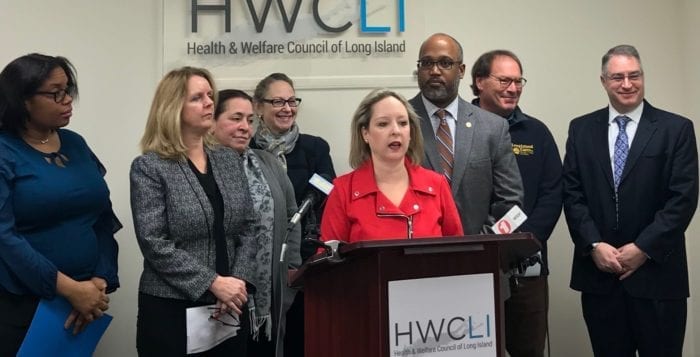By Lisa Scott
Somewhat quietly in late 2018, the Suffolk County Legislature and County Executive Steve Bellone (D) added an important tool to the fight for pay equity: The Restricting Information on Salaries and Earnings (RISE) Act.
The League of Women Voters of Suffolk County commends the entire Legislature and the county executive for taking this action. It is fair; it’s sound economics; it can reduce the need to pay for additional social support for working families; and it’s good for Suffolk County’s citizens. It shows that our county’s legislators and executive can work to reclaim their place as innovative, socially responsible elected officials while operating with foresight in a fiscally prudent manner.
Why should pay equity be a concern for us all? Race and gender are significant factors in what women earn for doing the exact same jobs as men. In April 2018, the New York State Department of Labor reported that Suffolk County women in general earn just 78.1 cents for every dollar a man earns. Comparably, black women are paid about 64 cents for every white male dollar, and the pay gap of Latina women is about 55 cents to a white man’s salary dollar.
Equal Pay Day in April reflects how long AFTER the end of the year a woman has to work before she takes home the same amount of earnings as a man in the prior year — thus, over 15 months of work for a woman to earn what a comparable man earned in 12 months!
Pay inequality isn’t just a women’s issue; it is a family issue. Recent research has found that 42 percent of mothers with children under the age of 18 are their families’ primary or sole breadwinners. Wage discrimination can impair their ability to buy homes and pay for a college education and limits their total lifetime earnings, thereby reducing their retirement savings and benefits.
Gender pay inequity and low wages put the burden of meeting the expenses of employees squarely on the backs of local taxpayers, who make up the difference in the costs of living with social safety net programs.
The pay gap not only hurts women and their families, but it also hurts the communities they support. That means local businesses are hurt through lost sales, as are local schools and governments that depend on sales tax and property tax dollars to fund the programs and the infrastructure those communities need to exist. In New York State, social service costs are paid directly by county governments that then must wait for state and federal reimbursement.
If pay equity makes good economic sense for our communities, how does the RISE act work toward this goal? The bill, which takes effect on June 30, 2019 was initially created to restrict employers from using salary and benefits history when establishing salary and benefits for new employees. The Legislature explained that utilizing this information in decision making perpetuates wage discrimination and the wage gap experienced by women, racial and ethnic minorities and employees returning to the workforce after an extended period away.
Gov. Andrew Cuomo (D) recently signed an “equal pay for work of equal value bill” that directs the president of the civil service commission to study and publish a report evaluating public employers’ wage disparities related to the job titles segregated by the gender, race and/or national origin of the employees in the title. Once completed, the study will be delivered to the governor and the leaders of the Legislature, and the data from the study will be used to address pay inequities in the state’s workforce.
“New York State has to be a leader on this issue — a model of reform,” the bill’s sponsor, Assembly member Barbara Lifton (D-Ithaca) said. “By getting our own house in order and ensuring that our public employees are being paid fairly for the work that they are doing, we are sending the wider message that wage disparities cannot be tolerated in a society that prides itself on treating everyone fairly.”
The NYS Legislature is only in session until June. We must advocate now to strengthen our equal pay laws so that women have the tools they need to fight back against pay discrimination.
The league’s work on pay equity stemmed from member concern over the feminization of poverty in the 1980s. Additional sources for pay equity information and advocacy include AAUW, PowHerNY, National Women’s Law Center and the Center for American Progress.
Lisa Scott is president of the League of Women Voters of Suffolk County, a nonprofit, nonpartisan organization that encourages the informed and active participation of citizens in government and influences public policy through education and advocacy. For more information, visit www.lwv-suffolkcounty.org or call 631-862-6860.












 “This deal puts an end to the uncertainty of this plant over the course of nine years and gives finality to this issue,” Romaine said. “I have always believed that all property assessments should be fairly based on property value.”
“This deal puts an end to the uncertainty of this plant over the course of nine years and gives finality to this issue,” Romaine said. “I have always believed that all property assessments should be fairly based on property value.”









